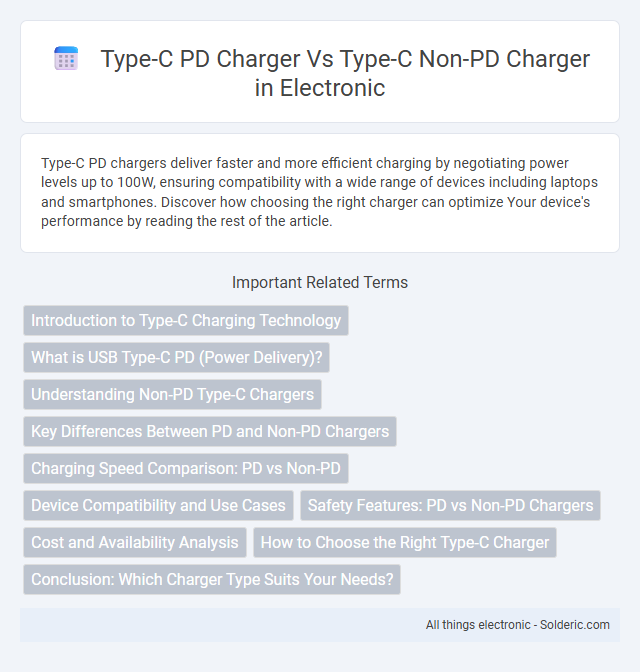Type-C PD chargers deliver faster and more efficient charging by negotiating power levels up to 100W, ensuring compatibility with a wide range of devices including laptops and smartphones. Discover how choosing the right charger can optimize Your device's performance by reading the rest of the article.
Comparison Table
| Feature | Type-C PD Charger | Type-C Non-PD Charger |
|---|---|---|
| Power Delivery (PD) Support | Yes, supports USB Power Delivery protocol | No, does not support USB Power Delivery |
| Charging Speed | Fast charging, up to 100W | Slower charging, typically up to 15W |
| Device Compatibility | Compatible with a wide range of PD-enabled devices | Compatible with basic USB-C devices without PD support |
| Voltage & Current | Variable voltage & current (5V-20V, up to 5A) | Fixed voltage & current (usually 5V, 1-3A) |
| Smart Power Management | Yes, negotiates optimal power delivery | No smart power negotiation |
| Price | Higher cost due to advanced tech | Lower cost, basic charging |
Introduction to Type-C Charging Technology
Type-C PD (Power Delivery) chargers offer dynamic voltage and current adjustment through intelligent communication between the charger and device, enabling faster and more efficient charging compared to Type-C non-PD chargers that deliver fixed power output. PD technology supports up to 100W of power transfer, making it suitable for a wide range of devices, including laptops, tablets, and smartphones, whereas non-PD chargers typically provide lower wattage limited to basic charging needs. The advanced negotiation protocol of Type-C PD ensures optimal power delivery tailored to device specifications, enhancing battery lifespan and reducing heat generation.
What is USB Type-C PD (Power Delivery)?
USB Type-C PD (Power Delivery) is a fast-charging protocol that delivers higher power levels up to 100W, enabling rapid charging of compatible devices such as smartphones, laptops, and tablets. Unlike Type-C non-PD chargers, which provide standard power output typically limited to 15W or 18W, PD chargers dynamically negotiate voltage and current to optimize charging efficiency and safety. Your devices can benefit from USB Type-C PD technology by charging faster and supporting a wider range of power requirements compared to traditional Type-C chargers without PD.
Understanding Non-PD Type-C Chargers
Non-PD Type-C chargers provide standard power delivery without supporting the Power Delivery (PD) protocol, limiting charging speed and device compatibility. Unlike Type-C PD chargers that dynamically negotiate voltage and current for fast and safe charging, non-PD chargers offer fixed power output, often resulting in slower charge times for modern smartphones and laptops. Understanding your device's power requirements helps ensure you use the correct charger type to optimize charging efficiency and protect your battery health.
Key Differences Between PD and Non-PD Chargers
Type-C PD chargers support Power Delivery technology, enabling dynamic power negotiation and faster charging speeds up to 100W, while non-PD Type-C chargers deliver fixed power output with slower charging rates. PD chargers are compatible with a wide range of devices, including laptops, tablets, and smartphones, offering optimized voltage and current adjustments for efficient energy transfer. Non-PD chargers lack these smart features, resulting in less efficient charging and limited device compatibility.
Charging Speed Comparison: PD vs Non-PD
Type-C PD (Power Delivery) chargers deliver higher wattage and dynamically adjust voltage and current to optimize charging speed, enabling devices to charge significantly faster compared to Type-C non-PD chargers that provide fixed power output. PD chargers can deliver up to 100W or more, reducing charging time for compatible smartphones, tablets, and laptops by up to 50% or more versus non-PD Type-C chargers, which typically max out at 15W to 27W. The intelligent power negotiation in PD chargers ensures efficient and safe fast charging, while non-PD chargers rely on standard USB power levels that result in slower, less efficient device charging.
Device Compatibility and Use Cases
Type-C PD chargers support fast charging across a wide range of devices including smartphones, laptops, and tablets, making them ideal for users requiring efficient power delivery. Non-PD Type-C chargers, while compatible with many devices, typically offer slower charging speeds and are best suited for smaller gadgets like wireless earbuds or older phones. Your choice should align with your device compatibility needs and intended use cases to ensure optimal charging performance.
Safety Features: PD vs Non-PD Chargers
Type-C PD chargers incorporate advanced safety features such as over-voltage protection, over-current protection, short-circuit protection, and temperature control, ensuring secure and reliable power delivery tailored to connected devices. In contrast, Type-C non-PD chargers often lack comprehensive safety protocols, increasing the risk of electrical damage or device malfunction. The Power Delivery (PD) standard actively negotiates power requirements, providing dynamic protection that non-PD chargers cannot match, making PD chargers a safer choice for modern electronics.
Cost and Availability Analysis
Type-C PD chargers generally cost more than Type-C non-PD chargers due to their advanced power delivery technology and faster charging capabilities. Availability of Type-C PD chargers is increasing rapidly in electronics stores and online marketplaces as demand for faster, compatible charging solutions grows. Your choice depends on balancing budget constraints with the need for efficient, high-speed charging support in modern devices.
How to Choose the Right Type-C Charger
Choosing the right Type-C charger depends on your device's power requirements and charging speed preferences. A Type-C PD (Power Delivery) charger provides faster, smarter charging by adjusting voltage and current, making it ideal for laptops, tablets, and smartphones that support PD protocols. For your devices without PD support or lower power needs, a Type-C non-PD charger offers a more affordable and sufficient charging solution.
Conclusion: Which Charger Type Suits Your Needs?
Type-C PD chargers provide faster charging speeds and higher power output, making them ideal for modern smartphones, laptops, and tablets requiring efficient energy delivery. Type-C non-PD chargers are suitable for basic devices with lower power demands, offering compatibility at a lower cost. Assessing your device's power requirements and usage patterns helps determine whether the advanced performance of a PD charger or the simplicity of a non-PD charger best suits your needs.
Type-C PD charger vs Type-C non-PD charger Infographic

 solderic.com
solderic.com